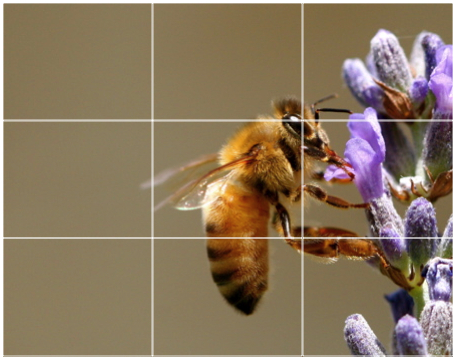Camera构图之三分法
原文:http://photoinf.com/Golden_Mean/Eugene_Ilchenko/GoldenSection.html
http://digital-photography-school.com/rule-of-thirds/
Golden Section and Photography
|
||||||||||||
|
||||||||||||

The Rule of Thirds is perhaps the most well known principle of photographic composition.
The “Rule of Thirds” one of the first things that budding digital photographers learn about in classes on photography and rightly so as it is the basis for well balanced and interesting shots.
I will say right up front however that rules are meant to be broken and ignoring this one doesn’t mean your images are necessarily unbalanced or uninteresting. However a wise person once told me that if you intend tobreak a rule you should always learn it first to make sure your breaking of it is all the more effective!
What is the Rule of Thirds?
The basic principle behind the rule of thirds is to imagine breaking an image down into thirds (both horizontally and vertically) so that you have 9 parts. As follows.

As you’re taking an image you would have done this in your mind through your viewfinder or in the LCD display that you use to frame your shot.
With this grid in mind the ‘rule of thirds’ now identifies four important parts of the image that you should consider placing points of interest in as you frame your image.
Not only this – but it also gives you four ‘lines’ that are also useful positions for elements in your photo.

The theory is that if you place points of interest in the intersections or along the lines that your photo becomes more balanced and will enable a viewer of the image to interact with it more naturally. Studies have shown that when viewing images that people’s eyes usually go to one of the intersection points most naturally rather than the center of the shot – using the rule of thirds works with this natural way of viewing an image rather than working against it.
In addition to the above picture of the bee where the bee’s eye becomes the point of focus here are some of examples:

Another Rule of Thirds Example
In this image I’ve purposely placed the head of my subject on one of the intersecting points – especially his eyes which are a natural point of focus for a portrait. His tie and flower also take up a secondary point of interest.

In this shot I’ve placed the subject along a whole line which means she is considerably off center and therefore creating an additional point of interest. Placing her right in the center of the frame could have resulted in an ‘awkward’ shot.
In a similar way a good technique for landscape shots is to position horizons along one of the horizontal lines also as I’ve done with the following shot (I’ll let you imagine the lines).

Using the Rule of Thirds comes naturally to some photographers but for many of us takes a little time and practice for it to become second nature.
In learning how to use the rule of thirds (and then to break it) the most important questions to be asking of yourself are:
- What are the points of interest in this shot?
- Where am I intentionally placing them?
Once again – remember that breaking the rule can result in some striking shots – so once you’ve learnt it experiment with purposely breaking it to see what you discover.
Lastly – keep the rule of thirds in mind as you edit your photos later on. Post production editing tools today have good tools for cropping and reframing images so that they fit within the rules. Experiment with some of your old shots to see what impact it might have on your photos.
Enjoy this tutorial about the Rule of Thirds? Get more free tips by subscribing to Digital Photography School.
Camera构图之三分法相关推荐
- 这次GDC China 2015的总结与关卡设计教程的梳理
去年关卡教程总结链接:听了GDC2014关于关卡设计的讲座的总结与自己的理解 24号去了GDC china听了讲座,没有听unity没有听VR,听了一天关卡教程,和上次的关卡教程还是有区别的,这次的关 ...
- 微信视频号如何运营?
视频号2020年1月中旬开始内测,部分好友具备发视频号权限(最早的一批视频号用户) 2020年2月份中旬视频号可以通过申请开通发布功能,当时网络上有很多二维码,扫描即可进入申请列表,然后正确填写信息, ...
- android6.0源码分析之Camera API2.0简介
1.Camera API2.0的架构图 Camera API2.0下的Camera架构与API1.0有所区别,下面将给出Camera API2.0以及Camera HAL3.2+下的Camera的总体 ...
- 安卓camera总体框架
今天是周五了,时间过得真快,通常这个时候,我都还沉醉了上班的状态中,说到上班,我是认真的,我非常喜欢上班,特别是今天,我会听到一声优美的声音,我的银行卡会多出一些钱,而这些最粗鲁的奖励也是我最讨厌的, ...
- 手机相机里面的m_荣耀V30 PRO详细评测:Matrix Camera相机矩阵开启5G视频时代
[IT168 评测]随着手机摄像头的配置越来越高,手机上已经能实现不俗的拍照效果,甚至超越了数码相机(DC)成为了人们最常用的拍照工具.进入今年的下半年,随着5G的商用,手机厂商对于手机的摄像头功能优 ...
- 系统相机裁剪比例_拍照时图片比例怎么选?比构图还要提前一步的摄影攻略要做好...
谈到摄影第一步,很多人都在说构图,但是比构图还要提前一步的,是选择合适的拍摄比例.在拍照时,始终是把要拍的东西装进设备的取景器里面,所以取景器的比例是16:9,还是4:3或者其他,就直接影响了我们如何 ...
- Android多媒体整体架构图
Android多媒体整体架构图 MediaPlayer框架图 Camera框架图 SoundRecorder框架图 VideoCamera框架图 OpenCore与Skia ALSA Audio框架图 ...
- 高通820(msm8996)camera hal源码分析
http://blog.csdn.net/lintwins/article/details/49783917 之前阅读过高通的camera的v4l2的driver,和video codec的drive ...
- 自定义拍照时 拍照界面_拍照时图片比例怎么选?比构图还要提前一步的摄影攻略要做好...
谈到摄影第一步,很多人都在说构图,但是比构图还要提前一步的,是选择合适的拍摄比例.在拍照时,始终是把要拍的东西装进设备的取景器里面,所以取景器的比例是16:9,还是4:3或者其他,就直接影响了我们如何 ...
最新文章
- mysql 连接 选库 查询
- 使用tensorflow书写逻辑回归
- 图的所有顶点间的最短路径(Floyd算法)
- 107 岁的 IBM 以 340 亿美元吞下了 25 岁的“小”红帽!
- 中英文对照 —— 色彩的描述
- Atitit.jdk java8的语法特性详解 attilax 总结
- 李宏毅自然语言处理——Self Attention
- jQuery进度条加载插件
- 【艾特淘】直通车数据化选款技巧
- 性能测试职业发展方向
- 音视频多媒体开发基础概述之颜色空间(1)CIE色度模型 RGB颜色空间
- python columns函数_pandas 对 column 使用函数
- xsocks 64位平台下编译问题小记
- 使用Python开发一个恐龙跳跳小游戏,玩起来
- 某大厂外包员工抢了个红包,被要求退回,太侮辱人了!千万别做外包,狗都不如...
- Pyinstaller Pmw
- 2019年编程语言排行榜,你还在犹豫吗?
- 【逻辑】500桶酒,其中1桶是毒酒,找毒酒
- 使用Keytool工具生成证书Keystore和证书签名请求文件
- Django网站建设-点击/收藏量、未读消息,错误页面显示404,500




